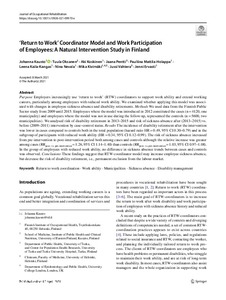‘Return to Work’ Coordinator Model and Work Participation of Employees: A Natural Intervention Study in Finland
Kivimäki Mika; Mattila‑Holappa Pauliina; Koskinen Aki; Kausto Johanna; Pentti Jaana; Vahtera Jussi; Oksanen Tuula; Ervasti Jenni; Kaila‑Kangas Leena; Nevala Nina
https://urn.fi/URN:NBN:fi-fe2021050328561
Tiivistelmä
Purpose Employers increasingly use ‘return to work’ (RTW) coordinators to support work ability and extend working
careers, particularly among employees with reduced work ability. We examined whether applying this model was associated with changes in employee sickness absence and disability retirements.
Methods We used data from the Finnish Public
Sector study from 2009 until 2015. Employees where the model was introduced in 2012 constituted the cases (n=4120, one
municipality) and employees where the model was not in use during the follow-up, represented the controls (n=5600, two
municipalities). We analysed risk of disability retirement in 2013–2015 and risk of sickness absence after (2013–2015) vs.
before (2009–2011) intervention by case–control status.
Results The incidence of disability retirement after the intervention
was lower in cases compared to controls both in the total population (hazard ratio HR=0.49, 95% CI 0.30–0.79) and in the
subgroup of participants with reduced work ability (HR=0.34, 95% CI 0.12–0.99). The risk of sickness absence increased
from pre-intervention to post-intervention period both among cases and controls although the relative increase was greater
among cases (RRpost- vs. pre-intervention=1.26, 95% CI 1.14–1.40) than controls (RRpost- vs. pre-intervention=1.03, 95% CI 0.97–1.08).
In the group of employees with reduced work ability, no diference in sickness absence trends between cases and controls
was observed.
Conclusions These fndings suggest that RTW-coordinator model may increase employee sickness absence,
but decrease the risk of disability retirement, i.e., permanent exclusion from the labour market.
Keywords Return to work coordination · Work ability · Municipalities · Sickness absence · Disability management
Kokoelmat
- Rinnakkaistallenteet [19207]
